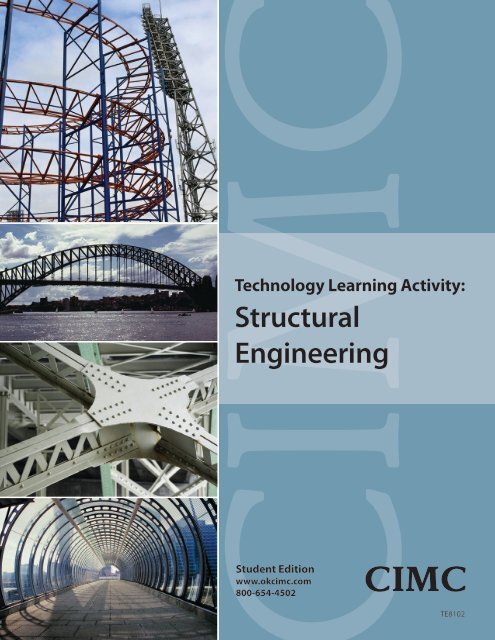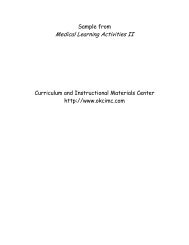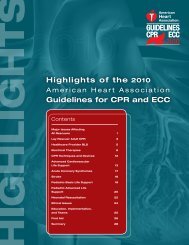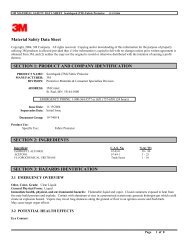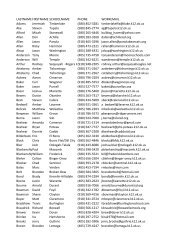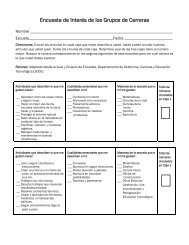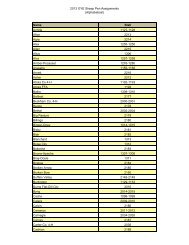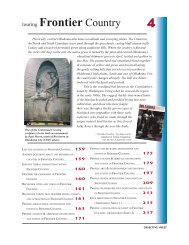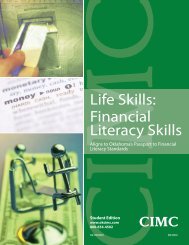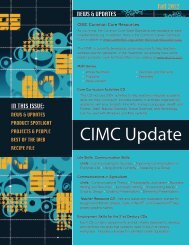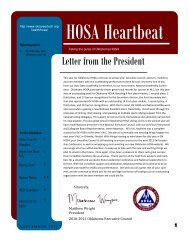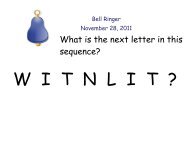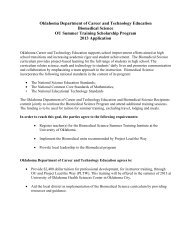Measuring (PDF file, 7.31 MB) - Oklahoma Department of Career ...
Measuring (PDF file, 7.31 MB) - Oklahoma Department of Career ...
Measuring (PDF file, 7.31 MB) - Oklahoma Department of Career ...
Create successful ePaper yourself
Turn your PDF publications into a flip-book with our unique Google optimized e-Paper software.
IMC<br />
Technology Learning Activity:<br />
Structural<br />
Engineering<br />
Student Edition<br />
www.okcimc.com<br />
800-654-4502<br />
CIMC<br />
TE8102
Structural<br />
Engineering<br />
Student Edition<br />
Developed by the<br />
Curriculum and Instructional Materials Center<br />
<strong>Oklahoma</strong> <strong>Department</strong> <strong>of</strong> <strong>Career</strong> and Technology Education<br />
TE8102
Copyright © 2010<br />
Project Manager:<br />
Design:<br />
Ann Wolfe<br />
Melinda Hawk<br />
<strong>Oklahoma</strong> <strong>Department</strong> <strong>of</strong> <strong>Career</strong> and Technology Education<br />
Curriculum and Instructional Materials Center<br />
All rights reserved.<br />
Printed in the United States <strong>of</strong> America by the<br />
<strong>Oklahoma</strong> <strong>Department</strong> <strong>of</strong> <strong>Career</strong> and Technology Education<br />
Stillwater, OK 74074-4364<br />
This publication, or parts there<strong>of</strong>, may not be reproduced in any form photographic, electrostatic,<br />
mechanical, or any other methods for any use including information storage and retrieval, without<br />
written permission from the publisher.<br />
Use <strong>of</strong> commercial products in these instructional materials does not imply endorsement by the<br />
<strong>Oklahoma</strong> <strong>Department</strong> <strong>of</strong> <strong>Career</strong> and Technology Education.<br />
Web site addresses were accurate and all content on referenced web sites was appropriate during<br />
the development and production <strong>of</strong> this product. However, web sites sometimes change; the<br />
CIMC takes no responsibility for a site’s content. The inclusion <strong>of</strong> a website does not constitute an<br />
endorsement <strong>of</strong> that site’s other pages, products, or owners. You are encouraged to verify all web<br />
sites prior to use.<br />
The <strong>Oklahoma</strong> <strong>Department</strong> <strong>of</strong> <strong>Career</strong> and Technology Education does not discriminate on the basis<br />
<strong>of</strong> race, color, national origin, sex/gender, age, disability, or veteran status.<br />
This publication could not have been printed without the expertise and commitment <strong>of</strong> the Printing<br />
Plant staff under the supervision <strong>of</strong> Danny Darrow. Delivery <strong>of</strong> the final product was accomplished<br />
through the excellence <strong>of</strong> the Curriculum Customer Service staff under the direction <strong>of</strong> Lana Austin,<br />
and the CIMC Warehouse staff, under the direction <strong>of</strong> Hank Martin.
Structural Engineering<br />
Table <strong>of</strong> Contents<br />
Lesson 1 <strong>Measuring</strong>...................................................................................................... 3<br />
Activity 1: Practice <strong>Measuring</strong>.................................................................................... 5<br />
Activity 2: More <strong>Measuring</strong>........................................................................................ 7<br />
Activity 3: Metric Prefixes........................................................................................... 9<br />
Activity 4: Measurement............................................................................................11<br />
Review/Quiz ..............................................................................................................13<br />
Lesson 2 Engineering and Disasters........................................................................ 15<br />
Activity 5: Disasters and Causes..............................................................................17<br />
Review/Quiz ..............................................................................................................19<br />
Lesson 3 Bridges and Other Structures .................................................................. 21<br />
Activity 6: Terms to Know......................................................................................... 27<br />
Activity 7: Sketch Bridges........................................................................................ 29<br />
Activity 8: Research bridges.................................................................................... 31<br />
Review/Quiz ............................................................................................................. 35<br />
Activity 9: Sketch Types <strong>of</strong> Trusses.......................................................................... 37<br />
Activity 10: Planning a Bridge Part 1....................................................................... 39<br />
Activity 11: Planning a Bridge Part 2........................................................................ 41<br />
Activity 12: Building/Testing a Bridge....................................................................... 43<br />
Activity 13: Strongest Structures.............................................................................. 45<br />
Activity 14: Build a Tall Tower................................................................................... 47<br />
Activity 15: Build Goo Structures............................................................................. 49<br />
Activity 16: Build Roller Coasters............................................................................. 51<br />
Activity 17: Solve Building Challenge....................................................................... 53<br />
Activity 18: Structural Marvels.................................................................................. 55<br />
Activity 19: Power Tool Racing/Engineering <strong>Career</strong>s............................................... 57
Structural Engineering<br />
Structural engineering is both a science and an art. It is a science<br />
because whatever is designed and built must withstand all the<br />
pressures and stresses it will be subjected to. Some <strong>of</strong> these stresses<br />
come from wind and weather. Other stresses are from gravity and<br />
earth movements that can cause minor shifting, or, in the worst case,<br />
earthquakes.<br />
Structural engineering is an art because, working with architects and<br />
possibly designers, the engineers plan the structures to be visually<br />
attractive and <strong>of</strong>ten elegant. It would be easy to build square or<br />
rectangular buildings, but if every building looked alike, imagine how<br />
boring it would look. These engineers design structures—everything<br />
from houses, theaters, stadiums, hospitals, and <strong>of</strong>fice buildings to<br />
bridges, oil rigs, and space satellites. Everything that is built must be<br />
structurally sound.<br />
Structural engineers usually design buildings and structures like dams,<br />
bridges, and towers. However they can also be involved in the design<br />
<strong>of</strong> machinery and medical equipment when the structural design is<br />
critical.<br />
What You Will Learn About:<br />
• <strong>Measuring</strong><br />
• Structural engineering disasters and prevention<br />
• Types <strong>of</strong> bridges and other structures<br />
• Modern structural marvels<br />
• <strong>Career</strong>s related to structural engineering<br />
Structural Engineering<br />
Structural Engineering<br />
CIMC — Copyright © 2010<br />
1
Structural Engineering<br />
What You Will Do:<br />
• Measure items around the classroom and your home.<br />
• Research one or two modern disasters and complete an<br />
information sheet about it.<br />
• Research types <strong>of</strong> bridges and, if approved by your instructor, other<br />
types <strong>of</strong> structures and write a short<br />
description <strong>of</strong> each.<br />
• Design, build, and test a bridge—your<br />
instructor will tell you whether it will be<br />
designed and built on the computer or<br />
from real materials.<br />
• Write an essay about the bridge-building<br />
process.<br />
• Design and build the tallest possible<br />
structure that will support a tennis ball<br />
for 30 seconds using drinking straws and<br />
masking tape or other materials approved<br />
by your instructor.<br />
• Complete assigned activities using The<br />
World <strong>of</strong> Goo s<strong>of</strong>tware. As you complete levels in the s<strong>of</strong>tware, you<br />
will list the physics principles that helped solve the level.<br />
• Using s<strong>of</strong>tware such as Roller Coaster Tycoon, Ultimate Ride<br />
Coaster, or other structure building s<strong>of</strong>tware, design, build, and test<br />
a coaster. Write a paragraph describing the success or failure <strong>of</strong><br />
your design.<br />
• Watch a DVD or TV show about modern marvels or big<br />
construction and complete an information sheet about it.<br />
• Solve a dam-building challenge.<br />
• Design and prepare a fi nal sketch <strong>of</strong> a power tool racer.<br />
Structural Engineering<br />
CIMC — Copyright © 2010<br />
2
Lesson 1:<br />
<strong>Measuring</strong><br />
People have been measuring items for a long time. The early systems<br />
<strong>of</strong> measurement were usually based on things like the length <strong>of</strong> a<br />
person’s arm, thumb, fi nger, or foot. This worked well if<br />
the person doing the measuring was personally using<br />
everything measured. Wood cut based on<br />
one person’s foot will fit together. But what<br />
might happen if more than one person was<br />
measuring pieces <strong>of</strong> wood, using his or<br />
her foot, that had to fit together? Would the<br />
wood be cut to the same size if two people<br />
were told to cut wood into 4-foot pieces, but one used the red foot and<br />
the other the purple foot? Does this sound like an accurate way to<br />
measure? Because <strong>of</strong> these problems and inaccuracies, people began<br />
to devise ways to make the units <strong>of</strong> measurement standard so that<br />
everyone would think the same thing when told something was four feet<br />
long. Today, units <strong>of</strong> measure are standardized throughout the world.<br />
Did You Know?<br />
Many <strong>of</strong> us use or have heard terms like “in a jiffy,” “just a tad,”<br />
and “a smidgeon.” According to Useless Measurement and<br />
Trivia (www.rob.neff.net/rob/trivia.html#<strong>of</strong>ftrack), the following<br />
are definitions <strong>of</strong> some <strong>of</strong> these measurements.<br />
skosh = 4 smidgeons<br />
smidgeon = couple tads<br />
1 tad = just a mite<br />
quite a little bit = 100 skosh<br />
bookoodles = 1000 quite a little bits<br />
jiffy = 3.3357x10-11 seconds<br />
Usually it is important to measure accurately, but sometimes<br />
measurements don’t have to be exact. For example, you may be given<br />
instructions to measure something “to the nearest inch.” This means<br />
that your answer should be in whole inches. When you are given this<br />
kind <strong>of</strong> specifi cation, your measurement may not be exact. It could<br />
be as far <strong>of</strong>f as one-half <strong>of</strong> the unit <strong>of</strong> measure. In this example, if<br />
the object you measured was 3¼", and you were asked to give the<br />
answer to the nearest inch, your answer would be 3". If you had said<br />
4", you would be more wrong than one-half the unit <strong>of</strong> measurement<br />
(in this case, ½"). This is known as a margin <strong>of</strong> error. If you are asked<br />
Structural Engineering<br />
Structural Engineering<br />
CIMC — Copyright © 2010<br />
3
Structural Engineering<br />
to measure an object to the nearest ½", your margin <strong>of</strong> error would be<br />
¼." This means you could be ¼" <strong>of</strong>f the exact measurement and still be<br />
correct. The margin <strong>of</strong> error is always one-half <strong>of</strong> the unit <strong>of</strong> measure.<br />
Structural engineers need to know how to measure accurately.<br />
<strong>Measuring</strong> accurately is important<br />
whenever you have to measure things,<br />
but it is especially important when<br />
designing and building structures that<br />
must withstand many different stresses<br />
and pressures. Think about times you have<br />
had to measure an item. What might have<br />
happened if you’d been inaccurate with<br />
your measurements?<br />
Looking at the picture on the left, you<br />
can see that the smaller the increment <strong>of</strong><br />
measurement, the smaller the line. Notice<br />
how the lines move up from ⅓ 2” to 1”.<br />
WEB ACTIVITY<br />
What‛s a Smoot?<br />
Browse several <strong>of</strong> the following<br />
websites to find out about “smoot.”<br />
http://web.mit.edu/spotlight/smoot-salute/<br />
http://www.washingtonpost.com/wp-dyn/content/<br />
article/2005/12/07/AR2005120702328.html<br />
http://en.wikipedia.org/wiki/Smoot<br />
http://lambda-chi.mit.edu/History.aspx#smoots<br />
http://www.boston.com/news/local/breaking_news/2008/10/<br />
post_23.html<br />
http://tech.mit.edu/V129/N27/smoot.html<br />
http://web.mit.edu/news<strong>of</strong>fice/2008/<br />
smoot-tt0924.html<br />
http://www.crossandcrescent.<br />
com/2006/02/measuring-smoot/<br />
How tall are you in smoots? _______________________<br />
How long is a football field (100 yards) in smoots? ______<br />
How many smoots are in a mile? ____________________<br />
Structural Engineering<br />
CIMC — Copyright © 2010<br />
4
What You Will Do:<br />
Activity 1<br />
Practice <strong>Measuring</strong><br />
In this activity, you will practice measuring. You will measure lines and<br />
shapes on paper. In Activity 2 you will measure objects in the classroom<br />
or in your home. You may also practice measuring on the internet.<br />
What You Will Need:<br />
• ruler, yardstick, and/or tape measure<br />
• paper and pencil or pen<br />
What to Do:<br />
1. How long are the following items?<br />
Structural Engineering<br />
Structural Engineering<br />
CIMC — Copyright © 2010<br />
5
Structural Engineering<br />
2. Pretend you lived before measurements were standardized. In<br />
your village, a foot is the length <strong>of</strong> a man’s foot. Measure the<br />
two feet below. If you were selling items by the foot, which <strong>of</strong> the<br />
“feet” would you rather use? Why? _______________________<br />
__________________________________________________<br />
If you were buying materials to build a house, which “foot” would<br />
you rather use? Why? _________________________________<br />
__________________________________________________<br />
3. If you bought 10 feet <strong>of</strong> “red foot,” how many inches would you<br />
get? ______________________________________________<br />
If you bought 10 feet <strong>of</strong> “purple foot?” _____________________<br />
Structural Engineering<br />
CIMC — Copyright © 2010<br />
6
Activity 2<br />
More <strong>Measuring</strong><br />
Use a ruler to measure parts <strong>of</strong> the lines below.<br />
1. To the nearest ½", how long is the line below? _______________<br />
2. To the nearest ½", how long is the line below? _______________<br />
3. To the nearest ¼", how long is the line below? _______________<br />
4. To the nearest ½", how long is the line below? _______________<br />
5. To the nearest ¼", how long is the line below? _______________<br />
6. To the nearest ½", how long is the line below? _______________<br />
7. To the nearest 1", how long is the line below? _______________<br />
Structural Engineering<br />
Structural Engineering<br />
CIMC — Copyright © 2010<br />
7
Structural Engineering<br />
8. Work with a partner, and with your instructor’s permission, measure<br />
three or more things around your school. Measure as accurately as<br />
your ruler, yardstick, or tape measure allows. On the lines below,<br />
list the item you are measuring and its dimensions. With your<br />
instructor’s permission, you may measure items at home.<br />
____________________________________________________<br />
____________________________________________________<br />
____________________________________________________<br />
____________________________________________________<br />
____________________________________________________<br />
____________________________________________________<br />
____________________________________________________<br />
____________________________________________________<br />
____________________________________________________<br />
____________________________________________________<br />
WEB ACTIVITY<br />
Practice your measuring skills at:<br />
www.rsinnovative.com/rulergame<br />
www.funbrain.com/measure<br />
How did your skills measure up? ___________________<br />
____________________________________________<br />
____________________________________________<br />
____________________________________________<br />
____________________________________________<br />
____________________________________________<br />
____________________________________________<br />
____________________________________________<br />
Structural Engineering<br />
CIMC — Copyright © 2010<br />
8
What You Will Do:<br />
Activity 3<br />
Metric Prefixes<br />
In this activity, you will learn about the metric system and metric prefixes.<br />
What You Will Need:<br />
• internet access or other source <strong>of</strong> metric prefi xes<br />
• paper and pencil or pen<br />
What to Do:<br />
Look at the ruler above. We all know what the inch marks mean, but<br />
what about the measurements on the bottom? You probably know that<br />
cm (centimeter) and mm (millimeter) are metric measurements.<br />
The metric system started in France late in the 18th century. It is<br />
a decimal system. It was started to replace, with standard units <strong>of</strong><br />
measure, the many different measuring units being used. The standard<br />
unit for measuring length is the meter. Its actual defi nition has changed<br />
over the years to make it more precise because our ability to measure<br />
has become more and more accurate. The key thing is that when we<br />
say a meter we all mean the same thing.<br />
Since the 1960s the International System <strong>of</strong> Units (Système<br />
International d’Unités in French, or SI) has been the internationally<br />
recognized standard metric system. Metric units are widely used<br />
around the world. According to the CIA’s World Factbook, only<br />
three countries—Burma, Liberia, and the US—have not<br />
adopted the SI, or metric system as their <strong>of</strong>ficial<br />
system <strong>of</strong> weights and measures. The US is the<br />
only industrialized nation that does not mainly<br />
use the metric system in its commercial and<br />
standards activities. It is slowly becoming<br />
more accepted in science, medicine,<br />
government, and many sectors <strong>of</strong><br />
industry.<br />
Structural Engineering<br />
Structural Engineering<br />
CIMC — Copyright © 2010<br />
9
Structural Engineering<br />
A standard set <strong>of</strong> prefi xes in powers <strong>of</strong> ten may be used to derive larger<br />
and smaller units from the base units. Different units <strong>of</strong> measure are<br />
made by adding a prefi x to the main unit. For example, a centimeter is<br />
one-hundredth <strong>of</strong> a meter—there are 100 centimeters in a meter.<br />
Visit the following website to learn about metric measurement. Fill in<br />
the prefi xes.<br />
http://www.unc.edu/~rowlett/units/prefixes.html<br />
1. 1 trillion bytes is a _____________________________________<br />
2. 1 billionth <strong>of</strong> a second is a _______________________________<br />
3. 1 thousand liters is a ___________________________________<br />
4. 1 hundred meters is a __________________________________<br />
5. 1 millionth <strong>of</strong> a liter is a _________________________________<br />
6. 1 tenth <strong>of</strong> a liter is a ____________________________________<br />
7. 1 million watts is a _____________________________________<br />
8. 10 grams is a _________________________________________<br />
9. 1 hundredth <strong>of</strong> a meter is a ______________________________<br />
10. 1 thousandth <strong>of</strong> a gram is a ______________________________<br />
11. 1 billion bytes is a _____________________________________<br />
12. 1 trillionth <strong>of</strong> a gram is a _________________________________<br />
One kilometer is about .6 (or ⅗) <strong>of</strong> a mile so 150 kilometers<br />
per hour equals 90 miles per hour (mph). Look at the picture<br />
<strong>of</strong> a metric odometer above. If the speed limit is 60 mph, is the<br />
car speeding? If it isn’t, how much faster could the car go? If it<br />
is, how much does it need to slow down?<br />
________________________________________________<br />
________________________________________________<br />
Structural Engineering<br />
CIMC — Copyright © 2010<br />
10
What You Will Do:<br />
Activity 4<br />
Measurement<br />
In this activity, you will practice measuring. You will measure lines and<br />
shapes using metric measures. You may also practice measuring on the<br />
internet.<br />
What You Will Need:<br />
• metric measuring tools<br />
• paper and pencil or pen<br />
What to Do:<br />
1. How long are the following items?<br />
2. Use a metric ruler to measure the following lines.<br />
Structural Engineering<br />
Structural Engineering<br />
CIMC — Copyright © 2010<br />
11
Structural Engineering<br />
3. Work with a partner, and with your instructor’s permission, measure<br />
the same things you measured in Activity 2. On the lines below,<br />
list the items and the metric measures. Think about how the<br />
measurements compare. Write some <strong>of</strong> your thoughts.<br />
____________________________________________________<br />
____________________________________________________<br />
____________________________________________________<br />
____________________________________________________<br />
____________________________________________________<br />
____________________________________________________<br />
____________________________________________________<br />
____________________________________________________<br />
____________________________________________________<br />
____________________________________________________<br />
____________________________________________________<br />
WEB ACTIVITY<br />
Practice your measuring skills at:<br />
www.funbrain.com/measure<br />
How did your skills measure up? ___________________<br />
____________________________________________<br />
____________________________________________<br />
____________________________________________<br />
____________________________________________<br />
____________________________________________<br />
____________________________________________<br />
____________________________________________<br />
Structural Engineering<br />
CIMC — Copyright © 2010<br />
12
Review/Quiz<br />
<strong>Measuring</strong><br />
Instructions: Answer the questions by filling in the circle beside the<br />
best possible answer.<br />
1. An early problem with measuring was caused by<br />
❍ a. different feet measuring different sizes<br />
❍ b. a lack <strong>of</strong> standard measurement<br />
❍ c. none <strong>of</strong> the above<br />
❍ d. all the above<br />
2. True or false? From the beginning <strong>of</strong> time, people measured<br />
things using yardsticks.<br />
❍ a. true<br />
❍ b. false<br />
3. If you are measuring to the nearest ½", your margin <strong>of</strong> error is<br />
❍ a. ¼"<br />
❍ b. ⅛"<br />
❍ c. 1"<br />
❍ d. ½"<br />
4. True or false? The most important thing about the meter is that it<br />
means the same thing to everyone.<br />
❍ a. true<br />
❍ b. false<br />
5. The standard unit <strong>of</strong> measure in the metric system is<br />
❍ a. liter<br />
❍ b. meter<br />
❍ c. yard<br />
❍ d. gram<br />
6. The metric system started in<br />
❍ a. Italy<br />
❍ b. Germany<br />
❍ c. France<br />
❍ d. England<br />
Structural Engineering<br />
Structural Engineering<br />
CIMC — Copyright © 2010<br />
13
Structural Engineering<br />
7. True or false? The <strong>of</strong>ficial system <strong>of</strong> weights and measures in the<br />
United States is the SI.<br />
❍ a. true<br />
❍ b. false<br />
8. How many centimeters are in a meter?<br />
❍ a. 100<br />
❍ b. 1,000<br />
❍ c. 10<br />
❍ d. 1<br />
9. How many bytes <strong>of</strong> memory does a computer have if it says one<br />
gigabyte?<br />
❍ a. one trillion<br />
❍ b. one thousand<br />
❍ c. one billion<br />
❍ d. one hundred<br />
10. How many grams are in a kilogram?<br />
❍ a. 100<br />
❍ b. 1,000<br />
❍ c. 10<br />
❍ d. 1<br />
Structural Engineering<br />
CIMC — Copyright © 2010<br />
14


